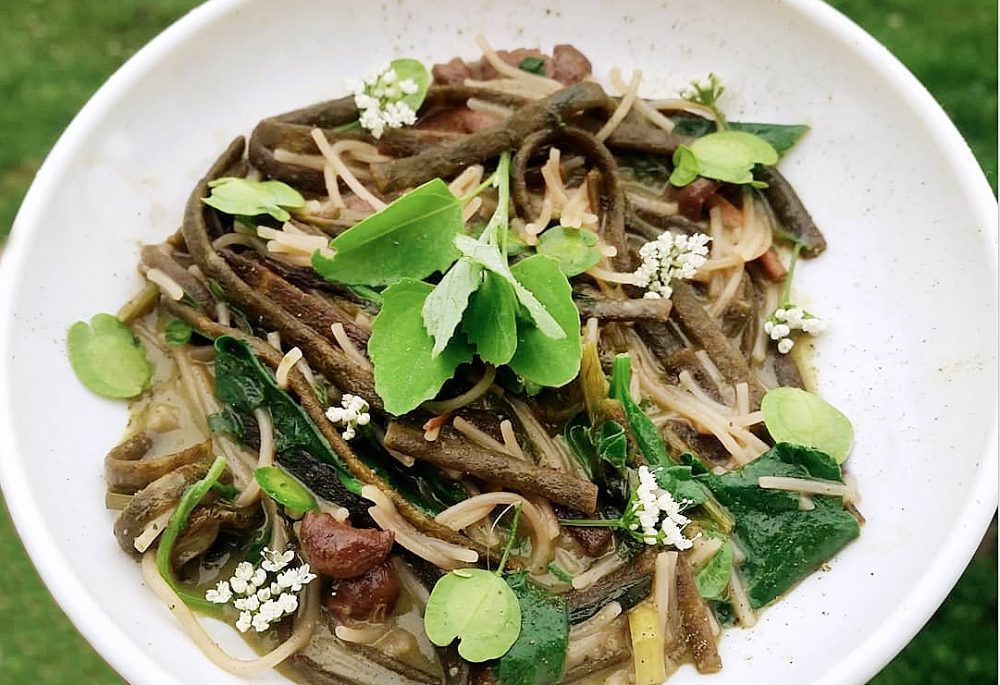
While you might not be able to forage Sea Spaghetti (Himanthalia elongata) from any of London’s green spaces, with the growing movement towards a grain or gluten free diet this amazing seaweed deserves a mention.
You can find sea spaghetti for sale at health food shops or you can easily buy it online. If you have access to the coast, an enormous luxury in during lockdown you could even harvest it yourself for free!
Sea spaghetti dries very well and it can be preserved like you would pasta and rehydrated when required just the same. It has a mild flavour compared to other seaweeds and if you harvest it before it reaches maturity it can be tender and taste just like spaghetti too.
If you do decide to harvest it yourself, please be aware that it is unable to reproduce if you cut it down to the hold fast (the little suction type button on the rock where the fronds stem out from). There are two branches stemming from near this base so I usually take one and leave the other. I’s highly unlikely you can misidentify this abundant seaweed because there are no lookalikes and if you think of a super sized spaghetti you will have no trouble spotting it on low tide.
Sea spaghetti, also known as Thong Weed, is one of my favourite seaweeds to harvest, simply for its diversity of uses in the kitchen from salads to carbonara. It is rich in calcium, zinc, magnesium, iodine and also contains the vitamins A, E, C, B1, B2, B7 and B9. It is not as rich in minerals as other varieties of seaweed, but it makes up for it in texture and flavour – I can eat tons of the stuff! (Maybe not literally…)
In this article I hope to show you just how easy it is to include sea spaghetti in a low carb and grain free diet without missing out on some of the mouth watering dishes we often associate with pasta.
Before that, let me tempt you with something as simple as:
SCALLOPS ON SEASPAGHETTI SALAD
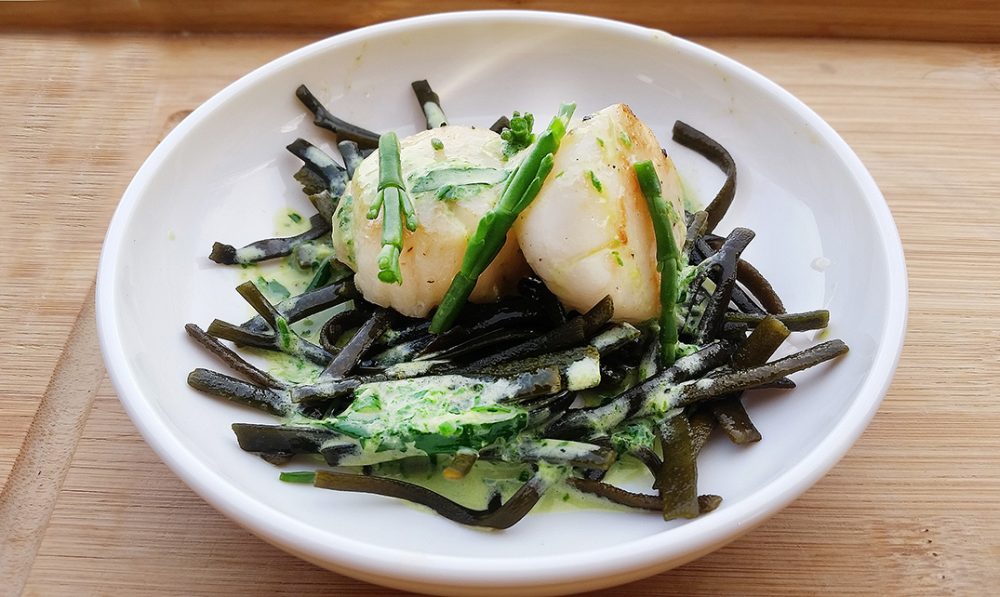
Is your mouth watering yet? Here is the recipe for this easy dish:
- Rehydrate a handful of dried sea spaghetti or as much as you desire.
- Make a simple garlic cream sauce. This one was made with organic soured cream and wild garlic.
- Fry the scallops and sear gently on both sides. Dish up a bed of sea spaghetti, place the scallops on top and drizzle with the wild garlic cream sauce. Top with salty, crunchy marsh samphire if you have it, spinach or something similar if not. Enjoy.
SEA SPAGHETTI CARBONARA
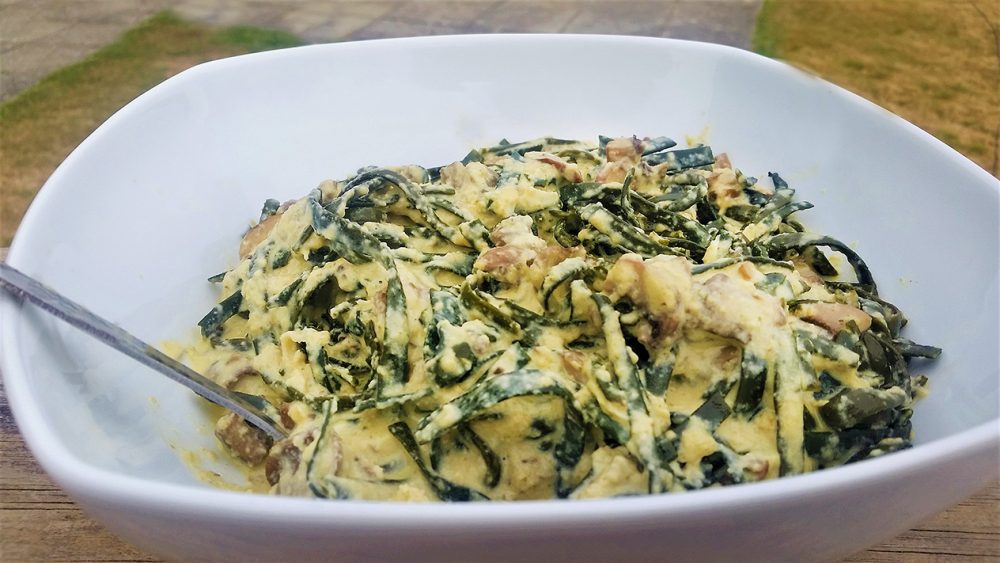
Last summer I had an itch that just would not go away. Since I’d met sea spaghetti for the first time in person and had refused to buy it from the shops, (not when I can harvest so much for free!). John, Forage London founder, came to visit me when I was gathering a couple of huge bags full of the stuff and yet barely touched the population that clung to the rocks. The pleasure that can be attained by simply knowing and experiencing where your food comes from cannot be bought and without it I feel like the chain is incomplete – from food to plate. So whilst you can purchase it and this will be far more convenient to most city folk, I do encourage you to take a weekend excursion to the coast when it is in season just so that you can experience this unique feeling and satisfaction for yourself and in the process hopefully gather a year’s supply to take home with you!
The first dish I played with was a delicious ‘Spaghetti’ Carbonara. It has been a while since I made this so the recipe might be a tad vague, but following the measurements of a standard carbonara recipe substituting spaghetti for Himanthalia elongata (Sea Spaghetti) you cannot go far wrong.
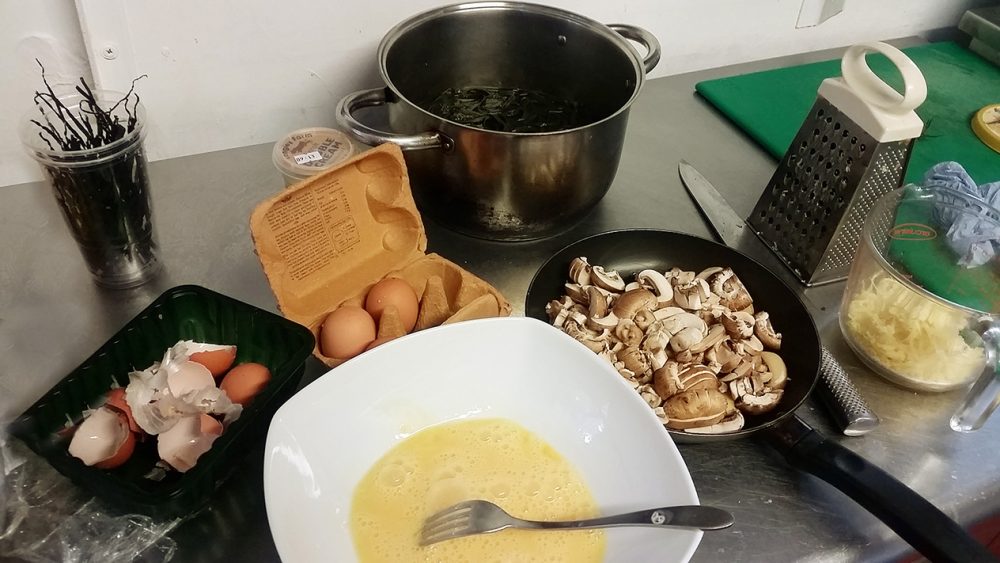
- Rehydrate the dried sea spaghetti in cold water and bring it to a boil.
- Panfry some mushrooms of your choice and cook any other additions like meat or vegetables.
- Grate some cheese of choice and add some crushed/chopped cloves of garlic (or in my case wild garlic powder) and a little salt and pepper to taste and then melt this all together.
- Beat 2-4 eggs (depending on how much sauce you are making) and sit to one side.
- After sea spaghetti is boiled and strained and the mushrooms (and any additions) are cooked then mix the melted cheese and stir the egg into it while it’s still hot. Cook a little if necessary.
This sea spaghetti carbonara was my first attempt at utilising this versatile seaweed and despite adding some older fronds, the taste and texture was almost spot on for spaghetti!
We are not finished yet – here are a few more dishes that I’ve experimented with using this amazing seaweed as a substitute for pasta.
LAMB AND CHEESE WITH SEA SPAGHETTI
The name couldn’t be any simpler and I hope the picture below speaks for itself.
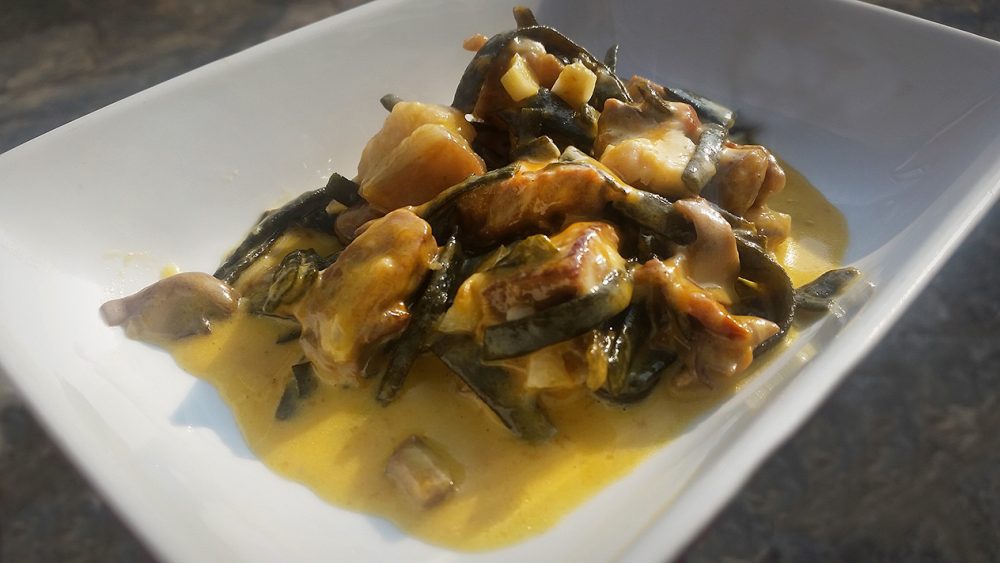
In this dish I wanted something quick, simple and low carb and after visiting a local farm shop for some organic grass fed and free range lamb, I also discovered some local red cheese. I took this all back to where I was staying during last summer and cooked up this amazing but simple dish.
- Chop up the lamb (I think I used steaks) into thumb sized chunks and fry in a pan with butter until nice and crispy but not over cooked on the inside.
- At the same time boil up some sea spaghetti and strain.
- Simply melt the grated cheese in with the lamb and sea spaghetti and cook for a minute on low heat so that it all blends together and serve (I cannot recall if I used another cheese to dilute this strong flavour) – but if you prefer something milder add another cheese into the mix.
Last but not least:
SEA SPAGHETTI STROGANOFF:
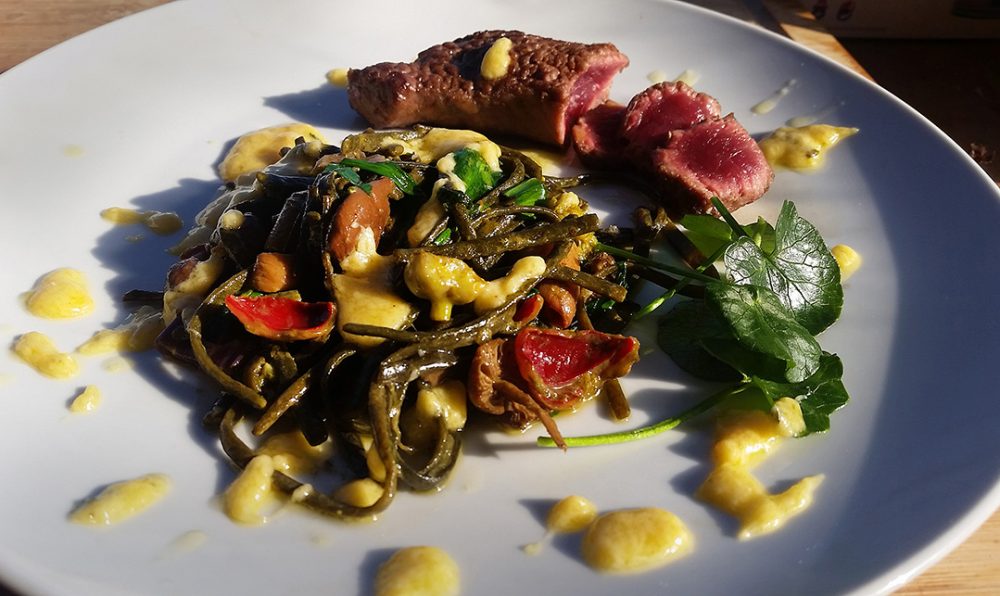
Here is another take on a traditional based dish and this one is one of my favourites. This meal was almost completely wild and foraged with the prime ingredients being: My own free range goat meat, fairy ring champignons, scarlet elf cups, wild garlic, alexanders and lesser celandine. Of course you can substitute these ingredients with whatever you have around you – the sea spaghetti is the star of the show here.
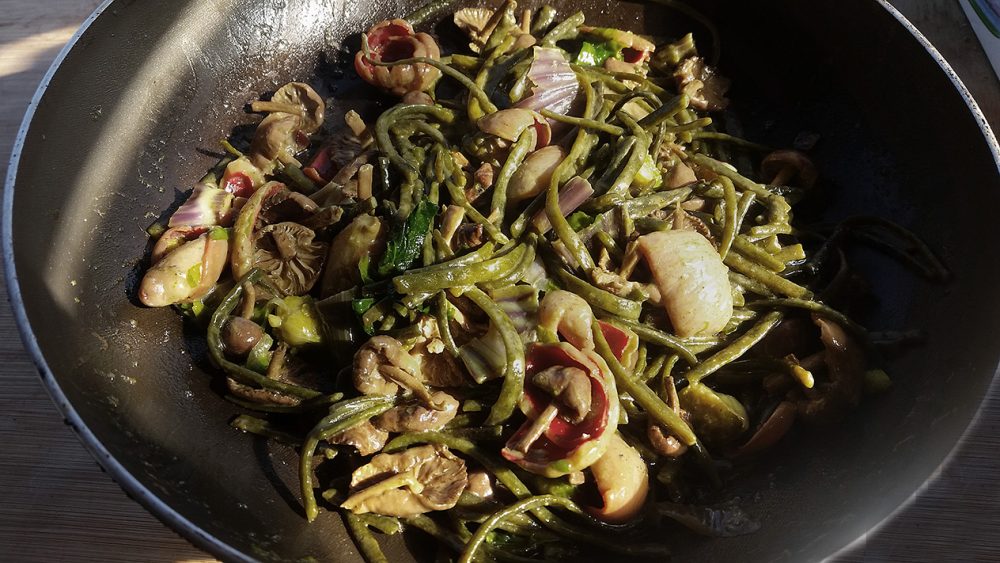
The process is as simple as:
- Boil and strain the sea spaghetti as before.
- Fry the mushrooms, vegetables and anything else you would like to use for the meal along with any seasonings such as wild garlic and onions. Add the sea spaghetti into the mix and cook together.
- Fry the venison/lamb/beef/goat separately if you would like to serve it like my dish and leave it rare on the inside.
- Melt cheese of your choice into a pan. I used gruyere and applbeby’s Cheshire which blended together amazingly well.
- Serve the sea spaghetti/mushroom/vegetable mix on a plate and finely cut the meat to serve alongside. Drizzle the melted cheese over the top and enjoy.
As you can see, cheese appears to be a running theme here, and perhaps I just love the stuff but it pairs amazingly well with sea spaghetti and provides the calories instead of using pasta – which is great for my low carb primal based lifestyle!
I’ve played around with sea spaghetti in other ways that also included a delicious soup, although I cheated here used rice noodles as a part of the dish in an experiment to combine the two textures and flavours. It’s still gluten free so could be a winner in some respects.
This delicious looking dish was created in the late spring and so I used various wild mustards greens such as field penny cress seed heads and also our native ‘wild spinach’ otherwise known as lamb’s quarters.
I hope this article has inspired you to use Himanthalia elongata in your daily recipes. It’s a wonderful and highly versatile seaweed and is also very common around our British shores. If you struggle to get out of London, even under more normal circumstances than the current ones, then the Cornish Seaweed Company has your back and can supply you with dried sea spaghetti to add to your kitchen shelves.
As with any wild food, or food in general, play around with it, experiment and see what other mouth-watering surprises you create. I will leave you with one final picture of inspiration and you guessed it! – It includes cheese…
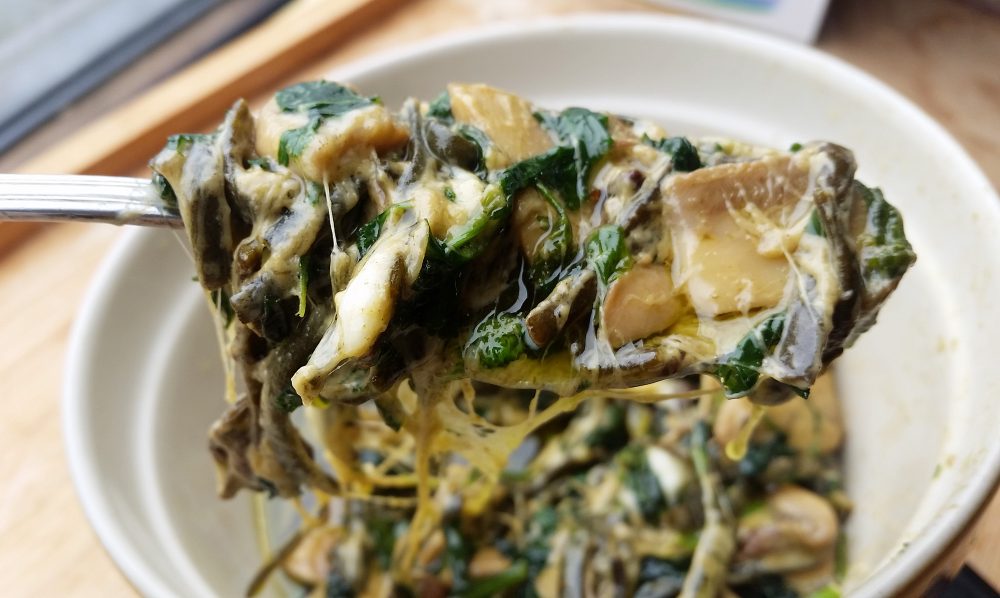
Bio:
Richard Mawby is a forager and a modern hunter gatherer. He has re-wilded his gut over a number of years and attains most of his nutrition from wild seasonal food alongside traceable food staples that closely mimic a true late-paleo diet.
He enjoys the outdoors, travelling, writing, inspiring, and being the change he wishes to see in the world whether it be through foraging courses, random encounters or eccentric journeys around the country on contraptions built from re-purposed junk and DIY stores (see his website for videos on the solar-powered tricycle).
Last summer he has succeeded in building a long range DIY electric car using up-cycled and recycled parts to create a low cost and practical vehicle. He has tackled the electric car market from another angle and has exhibited at Fully Charged Live earlier in the year as well as conducted talks on DIY electric vehicles at the Byline Festival August bank holiday.
Join him on his adventures through the website link below:
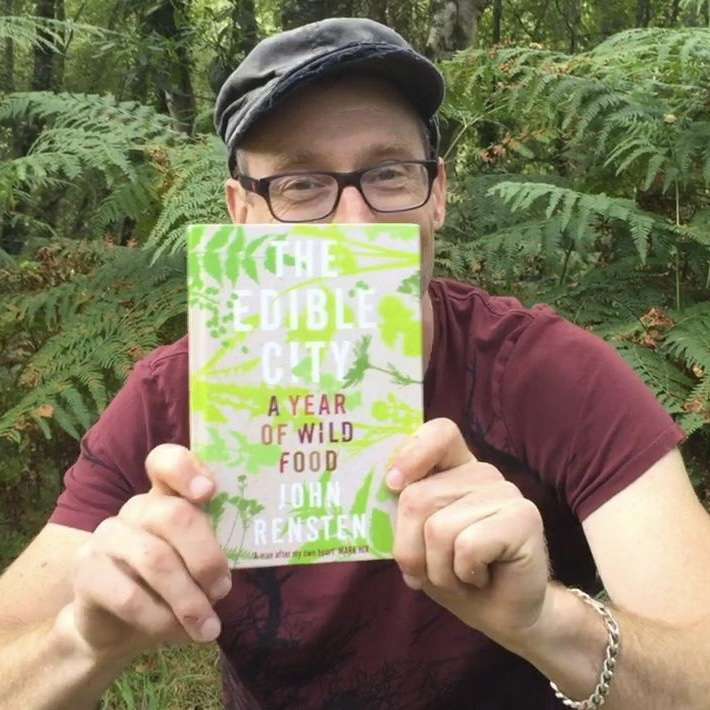
I up until recently lived on Ynys Môn and have lived there since the 70’s and have gathered wild mushrooms and some of the wild greens that I had a limited knowledge of. But I had no idea of the sea spaghetti that I used to wade through to get to clear water to cast a bass spoon. My recent discovery of Paul Kirtleys bush craft and survival podcast has led me to a number of wild food authors including yourself. Having left the island for good after some 40 years, I could kick myself for the opportunities I have missed gathering delicious wild delicacies. Hopefully my new home, not far from the North Sea will present the same opportunities
Hi Paul, I’m glad you enjoyed reading itAnd yes Paul Kirtley doesn’t Brilliant work.Happy foraging
I would like to know all about different seaweeds and how to cook . I already dry it and use as a herb in most cooking .
Interested